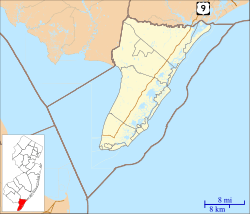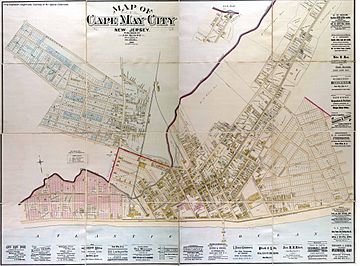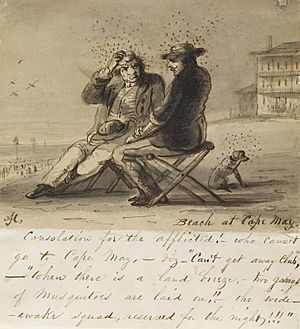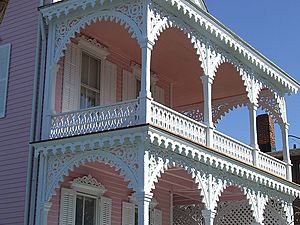Cape May Historic District facts for kids
|
Cape May Historic District
|
|
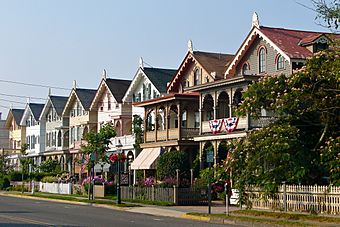
Stockton Cottages
|
|
| Location | Cape May, New Jersey |
|---|---|
| Area | 380 acres (1.5 km2) |
| Built | 1850 |
| Architectural style | Late Victorian |
| NRHP reference No. | 70000383 |
Quick facts for kids Significant dates |
|
| Added to NRHP | December 29, 1970 |
| Designated NHLD | May 11, 1976 |
The Cape May Historic District is a special area in Cape May, a popular beach town in New Jersey. It covers about 380 acres (1.5 square kilometers) and has over 600 buildings. Many people say Cape May was America's very first seaside resort. The buildings here are mostly from the late 1800s. They show off different styles of Victorian buildings. You can see styles like Eclectic, Stick, and Shingle, plus later Bungalow homes. Many have fancy "gingerbread trim," which is like decorative icing on a cake! An expert once said that Cape May has one of the biggest collections of old wooden buildings in the United States. It's like a living textbook of American building styles.
Contents
Exploring Cape May's Location
Cape May City is located at the very southern tip of the Cape May Peninsula. This peninsula separates the big Atlantic Ocean from the calmer Delaware Bay. Cape May City is right on the ocean. A place called Cape May Point is a bit to the west, next to the Bay.
Long ago, a tidal creek and marsh called Cape Island Creek separated the city from the rest of the land. But over time, parts of it were filled in. Today, the Cape May Canal, built in 1942, helps divide Cape May City and Cape May Point from the rest of the peninsula.
A Look Back: Cape May's History
Europeans first found the Cape May area on August 28, 1609. This was when Henry Hudson landed on the shore of Delaware Bay. Later, in 1621, Cornelius Mey explored the area more for the Dutch. By 1630, the Dutch bought land from Native Americans.
In 1632, the Dutch started a fishing and whaling settlement here. But by the 1630s, colonists from New England also moved in. The English took control in the 1660s. Early settlers worked in industries like lumber, shipbuilding, whaling, and fishing. A road built in 1796 helped Cape May grow into a small town.
Becoming a Popular Resort
Cape May became a popular summer resort early on because it was easy to get to by water. People from Philadelphia could travel by sloop (a type of sailboat). It was also easy to reach from New York, Baltimore, and Washington, D.C. Many visitors from the southern states also came for summer vacations.
The resort business really took off after the War of 1812. Regular steamboat trips on the Delaware River began. These boats brought many passengers from Philadelphia and New Castle, Delaware. Famous people, like Commodore Stephen Decatur, even had summer homes here.
The first version of the Congress Hall Hotel opened in 1816. It got its famous name in 1828. Around 1830, a visitor wrote that Cape May was a well-known "watering place." People came for the excellent sea bathing and pleasant drives on the beach. There was also great fishing nearby.
Many important people visited Cape May. Henry Clay came in 1847, and maybe even Abraham Lincoln in 1849. Several presidents visited while in office, including Franklin Pierce (1855) and Ulysses Grant (1873). President Benjamin Harrison even used Congress Hall as his Summer White House in 1891. From the 1850s to the 1880s, up to 3,000 visitors arrived every day in the summer!
Fires and New Buildings
During the 1850s, people started building summer cottages. More large hotels were also built. However, a big fire in 1856 destroyed the Mount Vernon Hotel before it was even finished. It was supposed to be the largest hotel in the world!
Competition arrived in 1854 when Atlantic City got a railroad connection to Philadelphia. Cape May didn't get its own railroad until the mid-1860s.
Many buildings in Cape May were made of wood. Because of this, several fires destroyed parts of the town. The fire of 1878 was a huge one, burning about half the town. But people quickly rebuilt many of the buildings. These new buildings often had lots of "gingerbread trim," gables (the triangular part of a wall under a sloping roof), and turrets (small towers).
A famous architect named Stephen Decatur Button designed many buildings in Cape May. He started in 1863 and designed over forty buildings in the town. Some of his well-known designs include the Stockton Cottages and the Windsor Hotel. Most buildings, though, were designed by local builders. They often copied ideas from older buildings or popular design books.
Changing Times
From about 1900 to 1920, larger bungalows and mansions were built. These were especially popular on Beach Avenue. As railroads and cars became more common, Cape May lost its advantage as a resort. Atlantic City became the most popular beach resort in New Jersey in the 1920s. Later, in the 1950s and 1960s, the Wildwoods (just north of Cape May) became a big competitor. The Wildwoods had its own unique style of buildings.
The Cape May Historic District was added to the National Register of Historic Places in 1970. It was then named a National Historic Landmark District in 1976. This means it's a very important place for American history and architecture.
Famous Buildings in Cape May
The Cape May Historic District has many important and beautiful buildings. Here are just a few examples of the special homes and hotels you can find there:
- George Allen House (1863-64): This is an elegant Italianate villa. It's known as one of New Jersey's most impressive seaside buildings from the 1800s.
- Atlantic Terrace Houses (1891-92): These are seven almost identical houses. They were built on the spot where the Atlantic Hotel used to be. They have three stories and face a quiet courtyard.
- Carroll Villa (1882): This hotel has an Eclectic Victorian style. It mixes different design ideas, including Italianate features.
- Chalfonte Hotel (1875, 1876, 1879, 1888): This is Cape May's oldest and most decorated large hotel. It has been added to many times over the years.
- Congress Hall (1879): This very large hotel has a three-story porch and a special mansard roof. Several presidents stayed here, including Benjamin Harrison.
- Cook's Villa (1879): Also known as Fryer's Cottage, this building is in the Second Empire style. It has a two-story porch with fancy tile decorations.
- Emlen Physick Estate (1878-79): This house is believed to have been designed by the famous architect Frank Furness. It looks very similar to another house he designed in Philadelphia.
- First Baptist Church (1879): This church was built in the Gothic Revival style. Its tall spire was sadly destroyed by lightning many years ago.
- Jackson's Clubhouse (1872): This building was originally a gambling club. It's considered one of Stephen Decatur Button's best designs still standing in Cape May.
- John B. McCreary House (1869-70): Also known as the Christian Science Society, this was another important design by Stephen Decatur Button.
- New Jersey Trust and Safe Deposit (1895): This small building was first a bank, then city hall, and is now a store. It's built in the Renaissance Revival style.
- St. John's Episcopal Church (1867-68): This church has beautiful original stained glass windows.
- St. Mary's Catholic Church (1911): This church is built in the Norman revival style. Its ceiling is decorated with stars!
- Jeremiah Schellenger House (1860): This is a unique two-story octagon house with Italianate details.
- Stockton Cottages (1872): These are a group of very similar cottages designed by Stephen Decatur Button. They have lavish outsides but simpler insides.
- Windsor Hotel (1879): This hotel was built right after the big fire of 1878. It had a fourth floor and an elevator added later in 1899.
Images for kids


